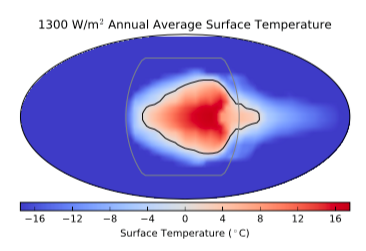Have you ever wanted to live on Antarctica? Me neither! So, what would make living on an ice-covered planet seem like such a good idea? Well, maybe not at the moment, but certainly in the future. There appears to be hope for ice-covered “snowball” planets after all.
It was previously believed that snowball planets were inhabitable because of their inability to nurture and maintain liquid water…and that pesky positive-feedback loop that keeps temperatures to extremely icy lows. However, there’s a catch! According to Earth’s history, it has been through two snowball periods. Earth is certainly habitable now, right? We are most certainly living it up on Earth’s crust, at least on the parts that aren’t the north or south poles (with the exception of Santa and his reindeer)!
The high albedo levels due to the sea ice can cause a snowball planet to maintain its icy cover even if it is hit with very high levels of greenhouse gases, or irregularly large amounts of sunlight. But there is hope! Earth seemed to return to temperate climates following its snowball periods. Additionally, there was no significant evidence of a loss of biodiversity. It would require lots of heating and melting–large increases in insolation and extreme levels of greenhouse gases might just do the trick. Maybe not enough to deglaciate an entire planet, but it is certainly possible for there to be habitable regions…which is still incredible, if you ask me!
The point that the authors are getting at is that it is not necessarily the case that low average global temperatures means a planet COMPLETELY covered in ice. The global averages don’t necessarily take into account some smaller regions that may contain warmer, habitable temperatures.

The Figure above displays an example of a hypothetical planet (centered on the equator) whose annual average surface temperature may signify a snowball planet, but which clearly shows a continent with a temperate, habitable climate. A planet such as this, with zero obliquity and a large amount of land on the equator may maintain a temperate climate, and therefore be habitable year-round.
The author claims that planets may be partially habitable or habitable at certain times of the year even when in a snowball period. He uses a General Circulation Model to show that this is possible for planets with high obliquity or high eccentricity. High obliquity would cause one part of the planet to have a lot more exposure to the sun than other regions. The same goes with high eccentricity– if a planet is very eccentric it means that at different times it will get more sun exposure than at others.
The discovery of possible habitability on snowball planets, even if not the entire planet, is a huge advance. As we continue our great quest for life on other planets, and for other habitable planets besides Earth, The infamous snowball planet is no longer a dud. It is rather, an opportunity for further exploration! This has expanded the original definition of what constitutes a “habitable’ planet.
Citation: